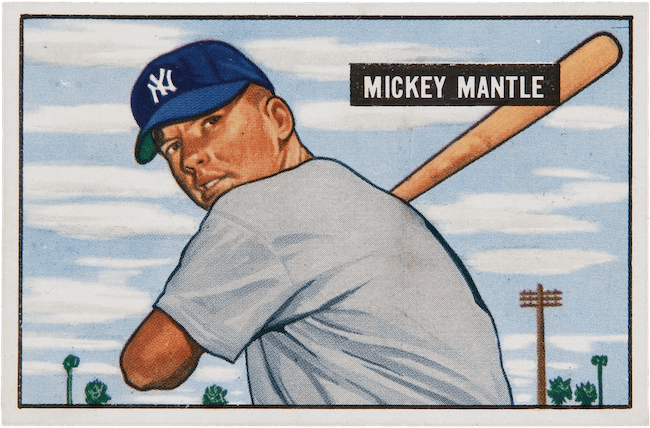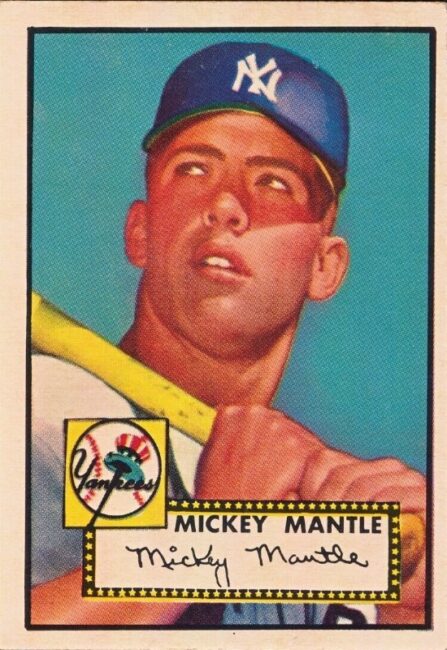The 1951 Bowman Mickey Mantle rookie card (#253) stands as a cornerstone in the world of baseball card collecting. It is the only true rookie card of one of the greatest hitters of all time and represents a post-war future for baseball cards, and baseball itself.
The card’s significance is also tied to the fierce rivalry between Bowman and Topps, which shaped the baseball card industry during that era. Bowman’s early recognition of Mantle’s potential demonstrates how companies competed to feature promising talent. While overshadowed in popular culture by Topps’ later releases, the 1951 Bowman Mantle remains a key historical artifact, representing both a milestone in Mantle’s career and a pivotal moment in the evolution of the trading card hobby.
Corporate Rivalry: Bowman vs. Topps

In the post-war period, the baseball card market was being reshaped. Baseball cards – previously included as promo items with tobacco, gum or food products – were starting to be seen as collectible in their own right. Bowman was the early frontrunner among card makers. Founded by J. Warren Bowman, the company had been producing baseball cards since 1948. By 1950, it had established itself as a leading manufacturer. The landmark 1950 Bowman set was notable for its hand-painted color reproductions of actual photographs, introducing a level of artistry and realism that set it apart from earlier card designs. This set helped bring the hobby back to the fans after a lull in the industry during the 1940s.
In 1951, Topps, a Brooklyn-based chewing gum company, entered the baseball card market with its first set. This move marked the beginning of a competitive rivalry with Bowman. Topps’ entry into the market introduced new dynamics, as both companies vied for control over the baseball card industry.
Bowman’s Rights to Mickey Mantle
In the early 1950s, baseball card companies didn’t just compete on design and distribution – they competed for players. Both Bowman and Topps realized that having star talent under exclusive agreements could make or break a set.
Bowman secured agreements with several promising rookies and established stars for their 1951 set. These contracts prevented the players from appearing on a rival company’s cards, giving Bowman a temporary advantage. Mickey Mantle, still a rookie in 1951, was among the players under Bowman’s umbrella. That’s why his first card appears in the Bowman set (#253).
Topps, entering the market in 1951, pursued a more aggressive approach. They offered higher pay and broader exposure for players, signing many to exclusive contracts for their 1952 set. This strategy ultimately allowed Topps to dominate the market. It also ensured that the 1952 Topps Mickey Mantle card became more widely distributed and recognized than Bowman’s first issue.
1951 Bowman Mickey Mantle Card
The 1951 Bowman set was a 324-card series that featured a mix of veterans and rookies. Mickey Mantle’s inclusion in this set is his only true rookie card. The card (#253) features a painted image of Mantle, as many cards leaned on art over photography in the early 1950s.
The production process of the 1951 Bowman cards was intricate. Each card was lithographed, a method that allowed for vibrant colors and detailed images. However, this process also made the cards susceptible to various printing defects, such as off-centering, rough cuts, and print lines. These imperfections have become characteristic of the set and contribute to the card’s charm and collectibility.
The Impact on the Hobby

The release of the 1951 Bowman Mickey Mantle card had a profound impact on the baseball card hobby. At the time, Mantle was a promising young player with the New York Yankees, and his inclusion in the Bowman set generated significant interest among collectors.
Despite its early popularity, the 1951 Bowman Mantle card was eventually overshadowed by the 1952 Topps Mantle #311 card. Topps’ more aggressive marketing and distribution strategies led to the 1952 card becoming more widely recognized and sought after. As a result, the 1951 Bowman Mantle card, while still highly valued, did not achieve the same level of fame.
Collectors often note that Mantle’s Bowman card represents a unique moment in the corporate tug-of-war between Bowman and Topps. This battle over players illustrates how corporate strategy directly shaped the hobby, influencing which cards became iconic and which became historical footnotes.
The Card’s Legacy
Today, the 1951 Bowman Mickey Mantle rookie card is considered one of the most valuable and iconic cards in the hobby. Its status as Mantle’s true rookie card, combined with the historical context of its production, has cemented its place in baseball card lore. Collectors and historians alike regard it as a symbol of the golden age of baseball cards and a testament to the enduring legacy of Mickey Mantle.
Despite Bowman’s early contributions to the hobby, Topps ultimately won the rivalry. Ironically, Topps now owns Bowman and issues cards under both brands. As the exclusive MLB licensee, Topps has effectively won the baseball card wars – at least for now – and remains the only company authorized to produce cards featuring MLB teams and players.
